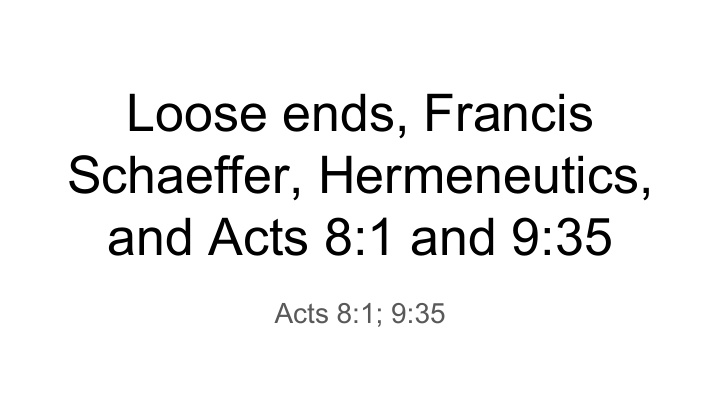



Loose ends, Francis Schaeffer, Hermeneutics, and Acts 8:1 and 9:35 Acts 8:1; 9:35
“Ultimately, whether he’s using hyperbole or not, I think we need to ask ourselves, ‘How is the answer to this going to help me follow Jesus better?’” (From the Sunday school recording on October 7, 2018, starting at approximately 36:36)
“...it seemed good to me also, having followed all things closely for some time past, to write an orderly account for you, most excellent Theophilus, that you may have certainty concerning the things you have been taught.” Luke 1:3-4
“Earlier when you were saying that you don’t maybe believe that the word ‘all’ really means ‘all,’ like ‘all the people’.... is it harder to write down that he healed someone, or harder to write down that all of them believed. If you’re not going to believe all the words that are written, how can you believe any of it? …. Well, if most of them did, then he could have written ‘most,’ or if some of them did, he could have written, ‘some.’” (From the Sunday school recording on November 18, 2018, starting at approximately 39:05)
“Truth doesn’t depend upon agreeing with me.” Francis Schaeffer, L’Abri, 1978
“Hyperbole is conscious exaggeration by the writer to gain effect. The last verse in the Gospel of John contains a classical example: ‘But indeed, there are many other things which Jesus did, which if they were written one by one, I do not suppose that the world itself could contain the books being written’ (John 21:25). John states here that his Gospel, like the others, is a selection of incidents and sayings from the life of Jesus. Hyperbole drives home the point.” Mickelsen, 193
“And there arose on that day a great persecution against the church in Jerusalem, and they were all scattered throughout the regions of Judea and Samaria, except the apostles.” Acts 8:1
“And all the residents of Lydda and Sharon saw him, and they turned to the Lord.” Acts 9:35
“The reference to all being converted is a Lukan hyperbole for a significant number coming to the Lord.” Darrell L. Bock, 377
“The news of Aeneas’s cure spread throughout the neighborhood and all over the coastal plain of Sharon. Many of the people in that area came to see him, and the result was a further access of believers. Since much of this territory was semi-Gentile in population, a further widening of the range of the saving message is implied.” Bruce (1988), 198
“A mass movement to the believing community on the part of the Jews in this district is implied.” Bruce (1990), 248
“His meaning is, that the miracle was published abroad, and was known throughout the whole city. For when the Scripture saith all, it doth not comprehend every one how many so ever it noteth; but it putteth all for the more part, or for many, or for the common sort of men. Therefore, the sense is, that whereas there was but a small number of godly men there, a great part of the people became members of the Church. And in this clause is expressed the fruit of the miracle, because they embraced Christ and his gospel.” Calvin, 397
“News of Aeneas’s healing spread throughout Lydda and into the Plain of Sharon to the north. Rather hyperbolically Luke says that ‘all those who lived in Lydda and Sharon saw him and turned to the Lord.’ The Plain of Sharon is the largest of the maritime plains of northern Palestine, stretching from Joppa to Mount Carmel and with Caesarea on the coast as its geographic center. So, Luke tells us, there was a further widening of the Christian mission within the Jewish nation, preparing the way geographically and ideologically for the accounts of Peter’s ministry at Joppa...and at Caesarea…” Longenecker, 381
“...the cure was accomplished by the name of Jesus, and this led to many conversions among the local people when they saw the healed man. Luke’s all the residents is his way of indicating a large number…” I. Howard Marshall, 179
“Many unbelievers -- in Lydda and the surrounding coastal plain of Sharon -- turned to Jesus as Lord (here and in v. 42), acknowledging his divine authority and saving power through the actions and words of his apostle.” Peterson, 321
“When Aeneas was healed, all those who lived in Lydda and Sharon (the coastal plain) saw him and turned to the Lord (35). Not that we need interpret the ‘all’ as meaning literally every single inhabitant, for, as Calvin wisely comments, ‘when Scripture mentions all, it is not embracing, to a man, the whole of whatever it is describing, but uses “all” for many, for the majority, or for a crowd of people’. Similarly, when Tabitha was restored to life, this became known all over Joppa, and many people believed in the Lord (42). In accordance with the purpose of the signs, which was to authenticate and illustrate the salvation message of the apostle, people heard the word, saw the signs, and believed.” Stott, 183-184
“Like most Synoptic miracle stories, this narrative ends in v. 35 with the response of the crowds -- ‘All those who lived in Lydda and the (plain of) Sharon saw him and turned to the Lord.’ Here the use of pas, as elsewhere in Acts, should not be taken literally but is an example of rhetorical hyperbole, intended to indicate a large response and to impress the hearer. Luke has no qualms about the idea that miracles can have an evangelistic value and effect.” Witherington, 330
“Truth doesn’t depend on agreeing with me.” Francis Schaeffer, L’Abri, 1978
Recommend
More recommend